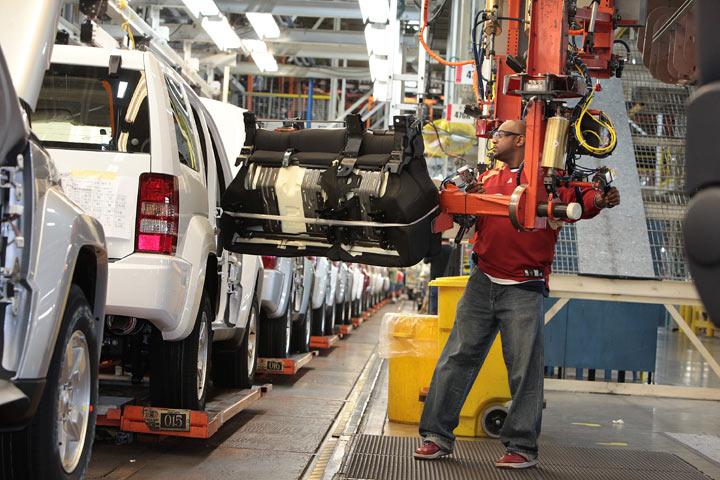Chrysler’s World Class Manufacturing Training Saving Millions in Cost
One project at the auto maker’s Kokomo, IN, transmission plant contributed to the savings by eliminating “micro-stoppages,” which are small equipment breakdowns.

PLYMOUTH, MI – Chrysler executive Mauro Pino says the auto maker’s World Class Manufacturing Academy in the U.S., a key element of improving quality, safety and productivity in its production facilities, accounted for $1 million in savings over the first six months in operation.
Pino, who heads Chrysler’s World Class Manufacturing system underlying the auto maker’s restructuring, says those savings will grow to $2.5 million by year’s end.
The implementation of WCM by Fiat in Europe in 2005 helped save the company from the U.S. equivalent of bankruptcy. Fiat Chairman and CEO Sergio Marchionne has, through Fiat’s investment in Chrysler, made a bet WCM will work as successfully in the U.S. as it did in Italy.
“The financial results of the home-plant projects have made the academy an excellent business case,” Pino tells a meeting of the Italian Trade Commission here, sponsored by WardsAuto sister publication IndustryWeek.
The WCM methodology reduces waste and increases productivity and quality by making the worker on the shop floor the starting point for change. But it is administered top-down, with executives and managers asking employees to buy into the system.
A complex but flexible system used at each of the 178 facilities in Fiat’s diversified empire, only one manufacturing site worldwide has achieved the highest “World Class” grade for implementation.
Two North American factories – Chrysler’s Dundee, MI, engine plant and Windsor, ON, Canada, assembly facility have crossed the first threshold to WCM status.
The WCM academy at the United Auto Workers union-Chrysler Technology Training Center in Warren, MI, is designed to accelerate the pace and rigor of the system’s implementation. Pino compares it to using a tutor to more quickly learn a foreign language.
So far, about 1,500 Chrysler workers have gone through the academy, and their new fluency is evident, Pino says.
For example, a project at the auto maker’s Kokomo, IN, transmission plant contributed to the $1 million savings by eliminating “micro-stoppages, ” which are small equipment breakdowns occurring when assembly pallets collide. The breakdowns are both costly and time consuming.
But after schooling employees at the WCM training center, the plant found the cause of the problem that was shutting the line down 15 times daily. Countermeasures were implemented to dampen the impact of the collisions and eliminate the recoil effect causing so much damage.
The machine in question has not witnessed a micro-stop in the three months since.
Pino says WCM’s tenet of reducing waste to zero, not just making notable decrease, leads to big savings. “The objective is zero waste. Zero accidents, zero breakdowns, zero inventory. Zero is a beautiful number to us.”
Reducing waste to zero, Pino adds, leads to sustainability. Without going to zero, wasteful, unreliable and unsafe habits can return. “To sustain savings is the key,” Pino tells WardsAuto in an interview ahead of his speech.
Pino says there has been some employee resistance to WCM since its introduction to Chrysler facilities in North America three years ago, in part because it was instituted by a foreign owner.
“It’s human nature to resist change,” admits Pino, who has rolled out WCM for Fiat at sites around the world and managed its implementation at Chrysler’s Toledo, OH, Jeep assembly complex.
“When I arrived in Toledo, they asked why I was there; why this guy from Italy is here,” he recalls. “I said I have one mission – to make this location attractive for investment. Then they understood very well. Best two years of my life.”
Late last year, Chrysler announced it would invest $1.7 billion at Toledo to build a next-generation Jeep SUV.
The results of WCM also are showing up in the marketplace, evidenced by Chrysler’s new financial ability to address customer dislikes. The auto maker’s sales are up 32.4% so far this year against an industrywide 13.4% gain on year-ago, according to WardsAuto data.
The auto maker’s share of the U.S. light-vehicle market increased to 11.5% through May, from 9.8% in like-2011.
“The cars we are producing now are much better than the cars we were producing in 2007 and 2008,” Pino says. “The implementation of the (WCM) system puts us in a (position) to attack the losses.”
Pino says the next step in the application of WCM will be rolling out the system at the weakest links in Chrysler’s supply chain.
About the Author
You May Also Like





